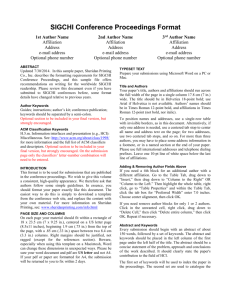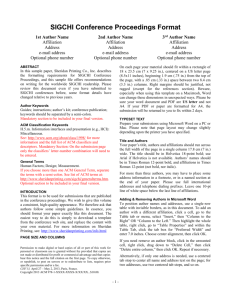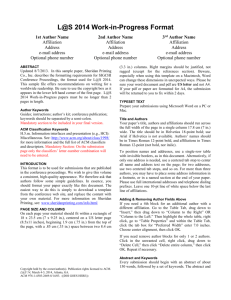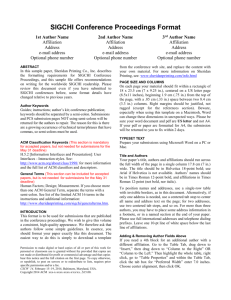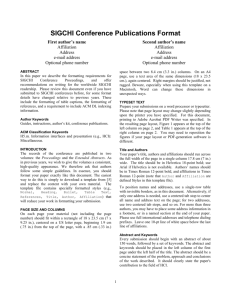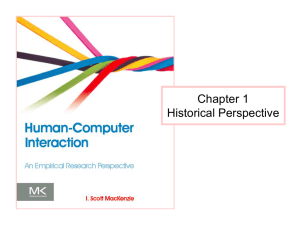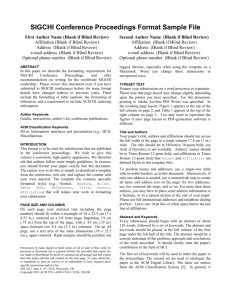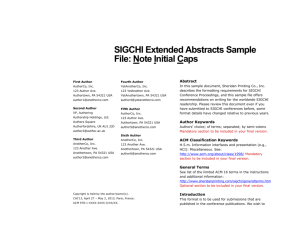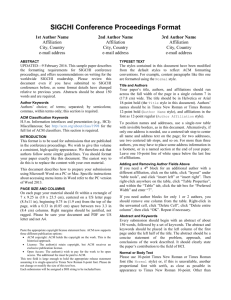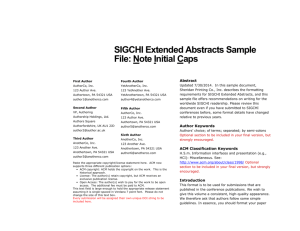SIGCHI Conference Proceedings Format
advertisement
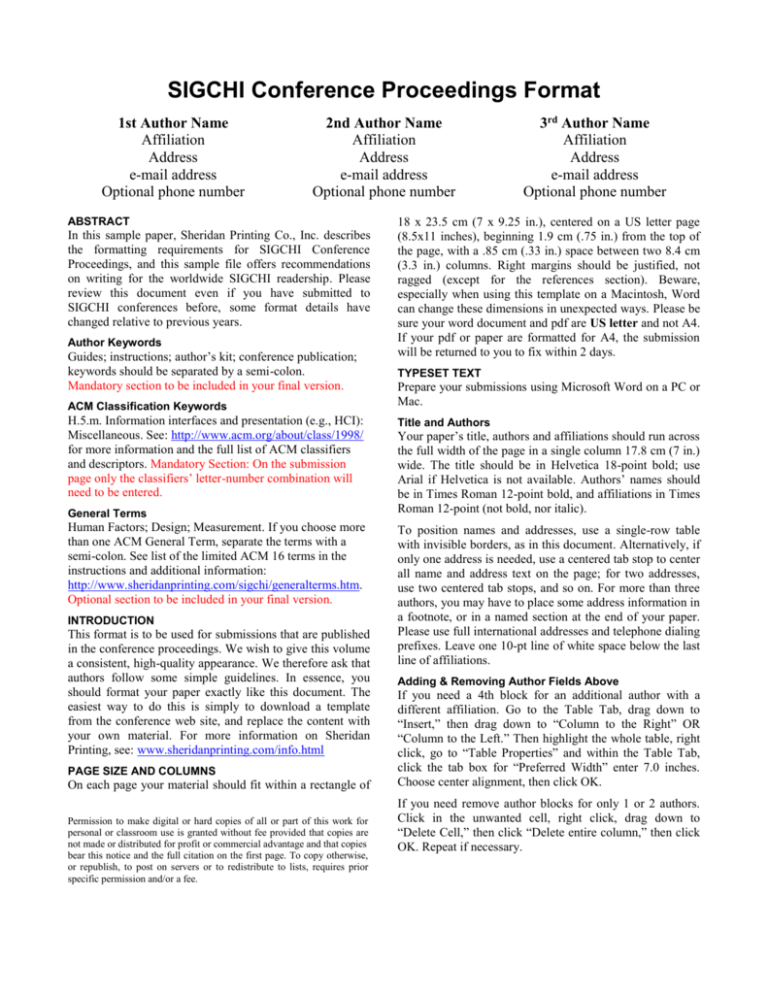
SIGCHI Conference Proceedings Format 1st Author Name Affiliation Address e-mail address Optional phone number 2nd Author Name Affiliation Address e-mail address Optional phone number ABSTRACT In this sample paper, Sheridan Printing Co., Inc. describes the formatting requirements for SIGCHI Conference Proceedings, and this sample file offers recommendations on writing for the worldwide SIGCHI readership. Please review this document even if you have submitted to SIGCHI conferences before, some format details have changed relative to previous years. Author Keywords Guides; instructions; author’s kit; conference publication; keywords should be separated by a semi-colon. Mandatory section to be included in your final version. ACM Classification Keywords H.5.m. Information interfaces and presentation (e.g., HCI): Miscellaneous. See: http://www.acm.org/about/class/1998/ for more information and the full list of ACM classifiers and descriptors. Mandatory Section: On the submission page only the classifiers’ letter-number combination will need to be entered. General Terms Human Factors; Design; Measurement. If you choose more than one ACM General Term, separate the terms with a semi-colon. See list of the limited ACM 16 terms in the instructions and additional information: http://www.sheridanprinting.com/sigchi/generalterms.htm. Optional section to be included in your final version. INTRODUCTION This format is to be used for submissions that are published in the conference proceedings. We wish to give this volume a consistent, high-quality appearance. We therefore ask that authors follow some simple guidelines. In essence, you should format your paper exactly like this document. The easiest way to do this is simply to download a template from the conference web site, and replace the content with your own material. For more information on Sheridan Printing, see: www.sheridanprinting.com/info.html PAGE SIZE AND COLUMNS On each page your material should fit within a rectangle of Permission to make digital or hard copies of all or part of this work for personal or classroom use is granted without fee provided that copies are not made or distributed for profit or commercial advantage and that copies bear this notice and the full citation on the first page. To copy otherwise, or republish, to post on servers or to redistribute to lists, requires prior specific permission and/or a fee. 3rd Author Name Affiliation Address e-mail address Optional phone number 18 x 23.5 cm (7 x 9.25 in.), centered on a US letter page (8.5x11 inches), beginning 1.9 cm (.75 in.) from the top of the page, with a .85 cm (.33 in.) space between two 8.4 cm (3.3 in.) columns. Right margins should be justified, not ragged (except for the references section). Beware, especially when using this template on a Macintosh, Word can change these dimensions in unexpected ways. Please be sure your word document and pdf are US letter and not A4. If your pdf or paper are formatted for A4, the submission will be returned to you to fix within 2 days. TYPESET TEXT Prepare your submissions using Microsoft Word on a PC or Mac. Title and Authors Your paper’s title, authors and affiliations should run across the full width of the page in a single column 17.8 cm (7 in.) wide. The title should be in Helvetica 18-point bold; use Arial if Helvetica is not available. Authors’ names should be in Times Roman 12-point bold, and affiliations in Times Roman 12-point (not bold, nor italic). To position names and addresses, use a single-row table with invisible borders, as in this document. Alternatively, if only one address is needed, use a centered tab stop to center all name and address text on the page; for two addresses, use two centered tab stops, and so on. For more than three authors, you may have to place some address information in a footnote, or in a named section at the end of your paper. Please use full international addresses and telephone dialing prefixes. Leave one 10-pt line of white space below the last line of affiliations. Adding & Removing Author Fields Above If you need a 4th block for an additional author with a different affiliation. Go to the Table Tab, drag down to “Insert,” then drag down to “Column to the Right” OR “Column to the Left.” Then highlight the whole table, right click, go to “Table Properties” and within the Table Tab, click the tab box for “Preferred Width” enter 7.0 inches. Choose center alignment, then click OK. If you need remove author blocks for only 1 or 2 authors. Click in the unwanted cell, right click, drag down to “Delete Cell,” then click “Delete entire column,” then click OK. Repeat if necessary. Abstract and Keywords Every submission should begin with an abstract of about 150 words, followed by a set of keywords. The abstract and keywords should be placed in the left column of the first page under the left half of the title. The abstract should be a concise statement of the problem, approach and conclusions of the work described. It should clearly state the paper's contribution to the field of HCI. The first set of keywords will be used to index the paper in the proceedings. The second set are used to catalogue the paper in the ACM Digital Library. The latter are entries from the ACM Classification System [3]. Normal or Body Text Please use a 10-point Times Roman font or, if this is unavailable, another proportional font with serifs, as close as possible in appearance to Times Roman 10-point. The Press 10-point font available to users of Script is a good substitute for Times Roman. On a Macintosh, use the font named Times and not Times New Roman. Please use sansserif or non-proportional fonts only for special purposes, such as headings or source code text. First Page Copyright Notice This sample word document has the correct ACM SIGCHI copyright notice in place (see page 1, bottom of column 1) Copyright will be held by ACM. Accepted extended abstracts and papers will be distributed in the Conference Publications. They will also be placed in the ACM Digital Library, where they will remain accessible to thousands of researchers and practitioners worldwide. To view ACM’s copyright and permissions policy, click this link: http://www.acm.org/publications/policies/copyright_policy Subsequent Pages On pages beyond the first, start at the top of the page and continue in double-column format. The two columns on the last page should be of equal length. this section ragged-right, so that the increasing number of references/citations with web addresses/urls do not have large word and letter spacing. For papers from conference proceedings, include the title of the paper and an abbreviated name of the conference (e.g., for Interact 2003 proceedings, use Proc. Interact 2003). Do not include the location of the conference or the exact date; do include the page numbers if available. See the examples of citations at the end of this document. Objects Caption – pre-2002 Caption – 2003 and afterwards Tables Above Below Figures Below Below Table 1. Table captions should be placed below the table. With Share Anyone Flight City 32% 29% SN Specific Future plans 35% 28% 37% 28% Past travels 45% 34% 18% 47% 35% 14% Flight City No one 5% 6% 3% 3% Table 2: Sharing travel plans Your references should be published materials accessible to the public. Internal technical reports may be cited only if they are easily accessible (i.e., you provide the address for obtaining the report within your citation) and may be obtained by any reader for a nominal fee. Proprietary information may not be cited. Private communications should be acknowledged in the main text, not referenced (e.g., “[Robertson, personal communication]”). SECTIONS The heading of a section should be in Helvetica 9-point bold, all in capitals (Heading 1 Style in this template file). Use Arial if Helvetica is not available. Sections should not be numbered. Subsections Figure 1. With Caption Below, be sure to have a good resolution image (see item D within the preparation instructions). References and Citations Use a numbered list of references at the end of the article, ordered alphabetically by first author, and referenced by numbers in brackets [2, 4, 5, 7]. Kindly make the text of Headings of subsections should be in Helvetica 9-point bold with initial letters capitalized (Heading 2). (Note: For subsections and sub-subsections, a word like the or of is not capitalized unless it is the first word of the heading.) Sub-subsections Headings for sub-subsections should be in Helvetica 9point italic with initial letters capitalized (Heading 3). Figure 2: Sample of a wide figure. Be sure to place at the top of the page or bottom of the page. FIGURES/CAPTIONS Place figures and tables at the top or bottom of the appropriate column or columns, on the same page as the relevant text (see Figure 1). consistently. Hyphenation is optional. To ensure suitability for an international audience, please pay attention to the following:1 Write in a straightforward style. A figure or table may extend across both columns to a maximum width of 17.78 cm (7 in.). Try to avoid long or complex sentence structures. Captions should be Times New Roman 9-point bold (Caption Style in this template file). They should be numbered (e.g., “Table 1” or “Figure 2”), centered and placed beneath the figure or table. Please note that the words “Figure” and “Table” should be spelled out (e.g., “Figure” rather than “Fig.”) wherever they occur. Explain all acronyms the first time they are used in your text – e.g., “Digital Signal Processing (DSP)”. Papers and notes may use color figures, which are included in the page limit; the figures must be usable when printed in black and white in the proceedings. The paper may be accompanied by a short video figure up to five minutes in length. However, the paper should stand on its own without the video figure, as the video may not be available to everyone who reads the paper. Inserting Images Occasionally MS Word generates larger-than-necessary PDF files when images inserted into the document are manipulated in MS Word. To minimize this problem, use an image editing tool to resize the image at the appropriate printing resolution (usually 300 dpi), and then insert the image into Word using Insert | Picture | From File... Table Style The text of tables will format better if you use the special Table Text style (in this template file). If you do not use this style, then you may want to adjust the vertical spacing of the text in the tables. (In Word, use Format | Paragraph… and then the Line and Page Breaks tab. Generally, text in each field of a table will look better if it has equal amounts of spacing above and below it, as in Table 1.) LANGUAGE, STYLE AND CONTENT The written and spoken language of SIGCHI is English. Spelling and punctuation may use any dialect of English (e.g., British, Canadian, US, etc.) provided this is done Briefly define or explain all technical terms that may be unfamiliar to readers. Explain local references (e.g., not everyone knows all city names in a particular country). Explain “insider” comments. Ensure that your whole audience understands any reference whose meaning you do not describe (e.g., do not assume that everyone has used a Macintosh or a particular application). Explain colloquial language and puns. Understanding phrases like “red herring” may require a local knowledge of English. Humor and irony are difficult to translate. Use unambiguous forms for culturally localized concepts, such as times, dates, currencies and numbers (e.g., “1-597” or “5/1/97” may mean 5 January or 1 May, and “seven o’clock” may mean 7:00 am or 19:00). For currencies, indicate equivalences – e.g., “Participants were paid 10,000 lire, or roughly $5.” Be careful with the use of gender-specific pronouns (he, she) and other gendered words (chairman, manpower, man-months). Use inclusive language that is genderneutral (e.g., she or he, they, s/he, chair, staff, staff-hours, person-years). See [6] for further advice and examples regarding gender and other personal attributes. If possible, use the full (extended) alphabetic character set for names of persons, institutions, and places (e.g., 1 Note that the items in this bulleted list were formatted using the Bullet Style (in this template file). Numbered lists are allowed. Grønbæk, Lafreniére, Sánchez, Universität, Weißenbach, Züllighoven, Århus, etc.). These characters are already included in most versions of Times, Helvetica, and Arial fonts. PAGE NUMBERING, HEADERS AND FOOTERS Your final submission SHOULD NOT contain any footer or header string information at the top or bottom of each page. The submissions will be paginated in a determined order by the chairs and page numbers added to the pdf during the compiling, indexing, and pagination processes. PRODUCING AND TESTING PDF FILES We recommend that you produce a PDF version of your submission well before the final deadline. Your PDF file must be ACM DL Compliant. The requirements for an ACM Compliant PDF are available at: http://www.sheridanprinting.com/typedept/ACM-distilling-settings.htm Test your PDF file by viewing or printing it with the same software we will use when we receive it, Adobe Acrobat Reader Version 7. This is widely available at no cost from [1]. Note that most reviewers will use a North American/European version of Acrobat reader, which cannot handle documents containing non-North American or non-European fonts (e.g. Asian fonts). Please therefore do not use Asian fonts, and verify this by testing with a North American/European Acrobat reader (obtainable as above). Something as minor as including a space or punctuation character in a two-byte font can render a file unreadable. CONCLUSION It is important that you write for the SIGCHI audience. Please read previous years’ Proceedings to understand the writing style and conventions that successful authors have used. It is particularly important that you state clearly what you have done, not merely what you plan to do, and explain how your work is different from previously published work, i.e., what is the unique contribution that your work makes to the field? Please consider what the reader will learn from your submission, and how they will find your work useful. If you write with these questions in mind, your work is more likely to be successful, both in being accepted into the Conference, and in influencing the work of our field. ACKNOWLEDGMENTS Sample Text: We thank all the volunteers, and all publications support and staff, who wrote and provided helpful comments on previous versions of this document. As well authors 1, 2, & 3 gratefully acknowledge the grant fron NSF (#1234-2012-ABC). This whole paragraph is just for example … Some of the references cited in this paper are included for illustrative purposes only. REFERENCES 1. Adobe Acrobat Reader 7, Be sure that the references sections text is Ragged Right, Not Justified. http://www.adobe.com/products/acrobat/. 2. Anderson, R.E. Social impacts of computing: Codes of professional ethics. Social Science Computing Review 10, 2 (1992), 453-469. 3. How to Classify Works Using ACM’s Computing Classification System. http://www.acm.org/class/how_to_use.html. 4. Klemmer, R.S., Thomsen, M., Phelps-Goodman, E., Lee, R. and Landay, J.A. Where do web sites come from? Capturing and interacting with design history. In Proc. CHI 2002, ACM Press (2002), 1-8. 5. Mather, B.D. Making up titles for conference papers. Ext. Abstracts CHI 2000, ACM Press (2000), 1-2. 6. Schwartz, M. Guidelines for Bias-Free Writing. Indiana University Press, Bloomington, IN, USA, 1995. 7. Zellweger, P.T., Bouvin, N.O., Jehøj, H., and Mackinlay, J.D. Fluid Annotations in an Open World. Proc. Hypertext 2001, ACM Press (2001), 9-18. The columns on the last page should be of approximately equal length. Remove these two lines from your final version.
